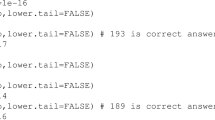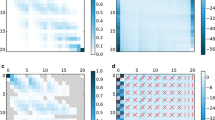Abstract
Phase-type distributions model the time until absorption in continuous or discrete-time Markov chains on a finite state space. The multivariate phase-type distributions have diverse and important applications by modeling rewards accumulated at visited states. However, even moderately sized state spaces make the traditional matrix-based equations computationally infeasible. State spaces of phase-type distributions are often large but sparse, with only a few transitions from a state. This sparseness makes a graph-based representation of the phase-type distribution more natural and efficient than the traditional matrix-based representation. In this paper, we develop graph-based algorithms for analyzing phase-type distributions. In addition to algorithms for state space construction, reward transformation, and moments calculation, we give algorithms for the marginal distribution functions of multivariate phase-type distributions and for the state probability vector of the underlying Markov chains of both time-homogeneous and time-inhomogeneous phase-type distributions. The algorithms are available as a numerically stable and memory-efficient open source software package written in C named ptdalgorithms. This library exposes all methods in the programming languages C and R. We compare the running time of ptdalgorithms to the fastest tools using a traditional matrix-based formulation. This comparison includes the computation of the probability distribution, which is usually computed by exponentiation of the sub-intensity or sub-transition matrix. We also compare time spent calculating the moments of (multivariate) phase-type distributions usually defined by inversion of the same matrices. The numerical results of our graph-based and traditional matrix-based methods are identical, and our graph-based algorithms are often orders of magnitudes faster. Finally, we demonstrate with a classic problem from population genetics how ptdalgorithms serves as a much faster, simpler, and completely general modeling alternative.





Similar content being viewed by others
References
Aalen, O.O.: Phase type distributions in survival analysis. Scand. J. Stat. 447–463 (1995)
Acal, C., Ruiz-Castro, J.E., Aguilera, A.M., Jiménez-Molinos, F., Roldán, J.B.: Phase-type distributions for studying variability in resistive memories. J. Comput. Appl. Math. 345, 23–32 (2019)
Albrecher, H., Bladt, M.: Inhomogeneous phase-type distributions and heavy tails. J. Appl. Probab. 56(4), 1044–1064 (2019)
Bladt, M., Nielsen, B.F.: Matrix-exponential Distributions in Applied Probability, vol. 81. Springer, New York (2017)
Bobbio, A., Horváth, A., Telek, M.: The scale factor: a new degree of freedom in phase-type approximation. Perform. Eval. 56(1–4), 121–144 (2004)
Cumani, A.: On the canonical representation of homogeneous markov processes modelling failure-time distributions. Microelectron. Reliab. 22(3), 583–602 (1982)
Duff, I.S., Erisman, A.M., Reid, J.K.: Direct Methods for Sparse Matrices. Oxford University Press, Oxford (2017)
Eisele, K.-T.: Recursions for compound phase distributions. Insur. Math. Econ. 38(1), 149–156 (2006)
Faddy, M., McClean, S.: Analysing data on lengths of stay of hospital patients using phase-type distributions. Appli. Stoch. Models Bus. Ind. 15(4), 311–317 (1999)
Frydenberg, M.: The chain graph Markov property. Scand. J. Stat. 333–353 (1990)
Goulet, V., Dutang, C., Maechler, M., Firth, D., Shapira, M., Stadelmann, M.: Expm: Matrix Exponential (2021). https://cran.r-project.org/package=expm
He, Q.-M.: Fundamentals of Matrix-Analytical Methods. Springer, New York (2014)
Hobolth, A., Bladt, M., Andersen, L.N.: Multivariate phase-type theory for the site frequency spectrum. J. Math. Biol. 83(6), 1–28 (2021)
Hobolth, A., Siri-Jegousse, A., Bladt, M.: Phase-type distributions in population genetics. Theor. Popul. Biol. 127, 16–32 (2019)
Kern, A.D., Hey, J.: Exact calculation of the joint allele frequency spectrum for isolation with migration models. Genetics 207(1), 241–253 (2017)
Kingman, J.F.C.: The coalescent. Stoch. Process. Appl. 13(3), 235–248 (1982). https://doi.org/10.1016/0304-4149(82)90011-4
Navarro, A.C.: Order Statistics and Multivariate Discrete Phase-Type Distributions (2019)
Neuts, M.F.: Matrix-Geometric Solutions in Stochastic Models: An Algorithmic Approach. John Hopkins University Press, Baltimore (1981)
Rivas-González, I., Andersen, L.N., Hobolth, A.: Phasetyper: phase-type distributions in r with reward transformations and a view towards population genetics. BioRxiv (2022). https://doi.org/10.1101/2022.06.16.496381
Younes, H.L., Simmons, R.G.: Solving generalized semi-Markov decision processes using continuous phase-type distributions. AAAI 4, 742 (2004)
Acknowledgements
We are grateful to two anonymous reviewers. Their useful comments and constructive suggestions helped improve a previous version of the manuscript.
Author information
Authors and Affiliations
Corresponding author
Additional information
Publisher's Note
Springer Nature remains neutral with regard to jurisdictional claims in published maps and institutional affiliations.
Rights and permissions
Springer Nature or its licensor (e.g. a society or other partner) holds exclusive rights to this article under a publishing agreement with the author(s) or other rightsholder(s); author self-archiving of the accepted manuscript version of this article is solely governed by the terms of such publishing agreement and applicable law.
About this article
Cite this article
Røikjer, T., Hobolth, A. & Munch, K. Graph-based algorithms for phase-type distributions. Stat Comput 32, 103 (2022). https://doi.org/10.1007/s11222-022-10174-3
Received:
Accepted:
Published:
DOI: https://doi.org/10.1007/s11222-022-10174-3




